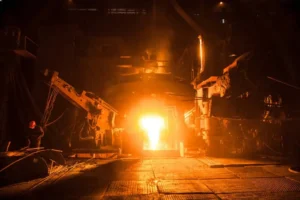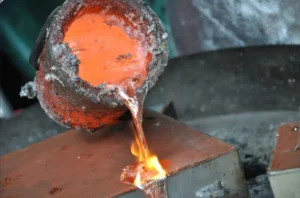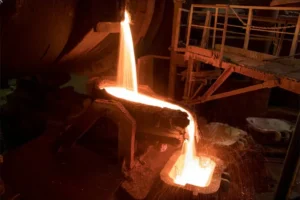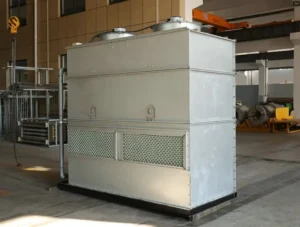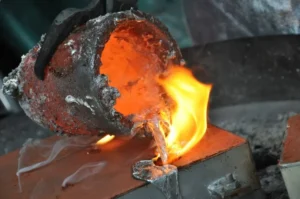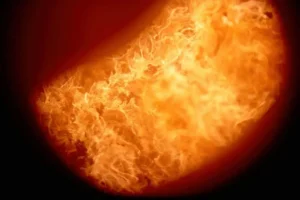Saat dunia berakselerasi ke arah pembersih, struktur energi yang lebih berkelanjutan, teknologi energi baru berkembang dengan kecepatan yang belum pernah terjadi sebelumnya. Dalam gelombang revolusi energi ini, perangkat industri yang tampaknya tradisional, itu tungku induksi, memainkan peran yang semakin penting dalam bidang-bidang utama seperti bahan baterai dan bahan penyimpanan hidrogen, menjadi “api yang tidak terlihat” mendorong kemajuan teknologi energi baru.
Menghidupkan Bahan Baterai, Keuntungan Sintering Induksi
Mulai dari ponsel pintar hingga kendaraan listrik, baterai lithium-ion sekarang ada di mana-mana. Kinerja inti baterai ini ditentukan oleh bahan katoda dan anodanya. Kualitas bahan-bahan ini, pada gilirannya, sebagian besar bergantung pada langkah produksi yang kritis: sintering.
Sintering, secara sederhana, adalah proses memanaskan bahan bubuk pada suhu tinggi untuk memadatkannya dan membentuk struktur kristal tertentu. Sementara sintering tradisional sering menggunakan resistensi atau tungku gas, Teknologi pemanasan induksi muncul sebagai alternatif yang unggul karena keunggulannya yang signifikan:
- Tepat, Cepat, dan efisien: Prinsip pemanasan induksi melibatkan penggunaan medan magnet bergantian untuk menghasilkan arus eddy dalam materi itu sendiri, menyebabkannya “Self-panas.” Metode ini sangat cepat, secara signifikan memperpendek siklus produksi. Lebih penting, karena panas dihasilkan langsung di dalam material, Kontrol suhu lebih tepat dan seragam. Ini menghindari ketidakkonsistenan suhu yang umum di tungku tradisional yang disebabkan oleh radiasi panas dan konduksi, dengan demikian memastikan konsistensi tinggi dan kinerja elektrokimia yang unggul dari bahan baterai.
- Hemat energi dan ramah lingkungan: Karena pemanasan internal langsung, efisiensi energi tungku induksi jauh lebih unggul dibandingkan tungku resistensi tradisional. Hal ini berarti konsumsi energi yang lebih rendah dan emisi karbon yang lebih sedikit, selaras dengan filosofi pembangunan ramah lingkungan dan rendah karbon dalam industri energi baru.
- Produksi dengan Kemurnian Tinggi Lingkungan: Pemanasan induksi tidak memerlukan pembakaran, sehingga terhindar dari kontaminasi dari kotoran bahan bakar. Tungku induksi yang beroperasi dalam ruang hampa atau atmosfer tertentu dapat memberikan hasil yang ideal, lingkungan bersih untuk sintering bahan baterai, terutama bagi mereka yang memiliki persyaratan kemurnian sangat tinggi seperti elektrolit padat.
Untuk teknologi baterai generasi berikutnya seperti baterai solid-state, sintering elektrolit keramik inti memerlukan kontrol yang lebih ketat terhadap suhu dan atmosfer. Presisi dan pengendalian sintering induksi menawarkan solusi yang ideal, berpotensi menerobos kemacetan teknis utama dalam industrialisasi baterai solid-state.
Membuka kunci kunci energi hidrogen, Potensi tungku induksi dalam menyiapkan bahan penyimpanan hidrogen
Hidrogen dipuji sebagai sumber energi pamungkas untuk abad ke -21, tapi itu “Achilles’ tumit” adalah cara menyimpan dan mengangkutnya dengan aman dan efisien. Bahan Penyimpanan Hidrogen, khususnya hidrida logam, dianggap sebagai solusi yang sangat menjanjikan.
Tungku induksi juga menunjukkan janji besar dalam persiapan paduan penyimpanan hidrogen:
- Homogenisasi komposisi paduan: Banyak bahan penyimpanan hidrogen berkinerja tinggi adalah paduan yang terdiri dari beberapa elemen logam. Efek pengadukan elektromagnetik yang dihasilkan selama peleburan induksi mendorong pencampuran logam cair secara menyeluruh, memastikan paduan akhir memiliki komposisi yang seragam. Hal ini menghasilkan kinerja penyimpanan hidrogen yang lebih stabil dan berulang.
- Persiapan Paduan Khusus: Untuk beberapa logam dengan titik leleh tinggi dan reaktivitas tinggi, peleburan induksi dapat dilakukan dalam kondisi vakum atau atmosfer pelindung. Ini secara efektif mencegah oksidasi dan kontaminasi material, menjadikannya pilihan ideal untuk menyiapkan kemurnian tinggi, paduan penyimpanan hidrogen berkinerja tinggi. Penelitian menunjukkan bahwa bahan penyimpanan hidrogen yang dibuat menggunakan teknologi peleburan induksi vakum menunjukkan kapasitas penyimpanan dan kinerja siklus yang sangat baik.
- Produksi yang Efisien dan Fleksibel: Tungku induksi dapat dihidupkan dan dihentikan dengan cepat, memungkinkan penyesuaian yang fleksibel berdasarkan kebutuhan produksi. Hal ini membuatnya sangat cocok untuk produksi uji coba skala kecil selama R&Fase D dan persyaratan manufaktur fleksibel untuk produksi komersial di masa depan.
Tantangan dan Prospek Masa Depan
Meskipun tungku induksi menunjukkan potensi besar di sektor energi baru, penerapannya secara luas masih menghadapi beberapa tantangan. Misalnya, bahan keramik isolasi memerlukan metode pemanasan induksi tidak langsung, dan biaya investasi awal untuk peralatan tersebut bisa jadi relatif tinggi.
Namun, manfaatnya jauh lebih besar daripada kerugiannya. Saat teknologi terus maju, tantangan-tantangan ini secara bertahap dapat diatasi. Di masa depan, teknologi pemanas induksi akan berkembang menuju kecerdasan dan otomatisasi yang lebih baik. Integrasi dengan Kecerdasan Buatan (AI) dan itu Internet Segalanya (IoT) akan memungkinkan pemantauan waktu nyata dan kontrol yang tepat terhadap proses sintering dan peleburan, lebih meningkatkan kualitas produk dan efisiensi produksi.
Hal ini dapat diperkirakan dengan terus mempopulerkannya kendaraan energi baru dan kematangan industri energi hidrogen secara bertahap, permintaan akan bahan baterai berkinerja tinggi dan bahan penyimpanan hidrogen akan mengalami pertumbuhan yang luar biasa. Pada saat itu, yang efisien, tepat, dan teknologi ramah lingkungan pada tungku induksi tidak diragukan lagi akan memainkan peran inti yang sangat diperlukan dalam produksi bahan energi baru, menyediakan yang kuat dan dapat diandalkan “api tungku” untuk membangun pembersih, masa depan energi yang lebih berkelanjutan.


